May 17, 2005
Originally Published MPMN May 2005
SPOTLIGHT
On Printing, Labeling, and Marking
Printing machines
A machine series is suitable for printing oblong components without having to give up the advantages of a sealed doctoring system. Because of the large printing surface, the possibility of setting the doctoring path to various cliché widths, as well as the cliché covers that are included as standard, allow the TSQ machine to be universally tuned to any product, such as catheters. The company’s RTI systems have the options of a horizontal or vertical operating rotary printing unit, which is especially useful in many types of automated systems. High-quality multicolor prints can be produced. Tampo Print International Corp., Vero Beach, FL www.tampoprint.com
Pad printers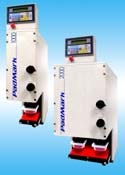
Pad printers can mark from one to four colors using sealed or enclosed inking systems. Features include modular design, automatic pad cleaning, and viscosity control. A quick-change inking system accommodates multiple applications. Customized part fixtures and part-handling equipment are also available to provide the proper level of automation needed for cost-effective production. Automated Industrial Systems, Erie, PA www.padmark.com
Covert optical security feature
A covert optical watermark security feature can be used to authenticate and validate a product. AuthentiKey includes a hidden watermark that can be embedded in the graphics of any package and can be printed using flexographic, ultraviolet flexographic, or offset print technologies. Multiple watermarks can be embedded in the graphics and are detected using a lens key to unlock the embedded image. Different keys may be employed throughout the supply chain to ensure security and conformity of product. Tursso Co., St. Paul, MN www.tursso.com
Thermal-transfer printer
An in-line thermal traversing system can meet multiple package coding and bar code requirements on all horizontal form-fill-seal equipment. The EasyPrint MLP includes a printhead that moves on a linear rail to code up to 30 packages in one pass, eliminating the need for multiple coders. It has a print area of up to 5 in. in width. This traversing feature replaces hot-stamp ribbon and metal type. The unit is driven by a stepper motor that is program logic controlled and offers an E Prom cartridge, which eliminates the need for in-field programming. Bell-Mark, Pine Brook, NJ www.bell-mark.com
Ink-jet nozzle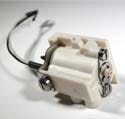
A nozzle features field-replaceable components that can be easily cleaned or swapped out by in-house operators, eliminating the need to replace the entire nozzle assembly. To further reduce operating costs, the EZ Jet nozzle can accept all orifice sizes used with Videojet Excel–series printers from 36 to 120 µm. InkJet Inc., Willis, TX www.inkjetinc.com
Printer and label software
A company offers a printer and software for labeling. MaxiLabelV2 software includes more than 500 ANSI safety symbols for making OSHA-compliant safety labels and signs. The software also contains more than 600 general industrial and office symbols. The LabelShop 2010-PC printer connects to a laptop or PC with a USB cable and features a footprint that fits anywhere on a desk or a laboratory bench. Users can print custom labels with industrial-grade adhesive in 23 different color combinations from 1¼6 to 1 in. wide. Special shrink-tube labeling material can also be used in the printer for wire, cable, medical instrument, or personal item identification. K-Sun Corp., Somerset, WI www.ksun.com
Case-printing equipment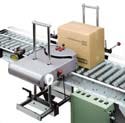
An in-line bar code printer is available for corrugated shipping containers. The Sidewinder uses a computer-generated printing stencil, which allows exact placement of very-high-resolution printing anywhere within the 2 ¥ 23-in. print area. The quality is sharp and brilliant at a maximum rate of 100 ft/min. The printer is suitable for average batch runs of 10,000 cases. Iconotech, Clinton, CT www.iconotech.com
Engraving and cutting systems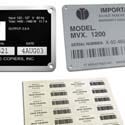
Air-cooled CO2 laser engraving and cutting systems are used for making labels for medical equipment and for marking medical devices. Laser systems cut, engrave, etch, and mark on a wide variety of materials from plastics and wood to stainless steel and marble. With standard graphic software such as AutoCad, one laser system functions like a printer from Windows XP and makes labels, identification tags, bar codes, and nameplates. Laser systems can mark metal directly with special optics. Systems range from 16 ¥ 12 in. to 48 ¥ 24 in., with power from 25 to 300 W to handle multiple laser processing applications. Universal Laser Systems Inc., Scottsdale, AZ www.ulsinc.com
Thermal printer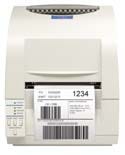
A rugged desktop printer has both thermal- transfer and direct thermal capabilities. The CLP-621 offers complete connectivity options, including internal Ethernet, along with a high-lift print mechanism. The unit uses an internal power supply. Citizen Systems America, Torrance, CA www.citizensystemsamerica.com
Label printer-applicator
A label printer-applicator is a lightweight, in-line unit. The Model 2600 offers a selection of thermal and thermal-transfer print engines. The units print 203- or 300-dpi text bar codes and graphic images at speeds up to 12 in./sec, and will dispense labels up to 4.5 in. wide and 6 in. in length. Labels are printed in a next-out mode and then immediately applied to cartons or products on the production or packaging line. Using the tamp-blow method of application, a printed pressure-sensitive label is peeled from its liner and is retained by vacuum on the applicator’s tamp pad. The pad is extended and the label is blown on to the surface from approximately 0.25 in. Weber Marking Systems, Arlington Heights, IL www.webermarking.com
Copyright ©2005 Medical Product Manufacturing News
You May Also Like


